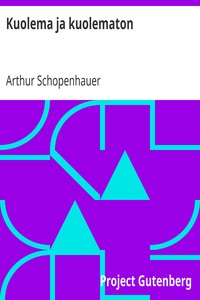Kuolema ja kuolematon by Arthur Schopenhauer
"Kuolema ja kuolematon" by Arthur Schopenhauer is a philosophical treatise likely written in the late 19th century. This work explores the concepts of death and the immortality of our essence, challenging the perception of life, existence, and the nature of desire through Schopenhauer’s unique lens of pessimism. The text delves into deep metaphysical considerations about the nature of the will, understanding, and the inherent suffering tied to existence. The opening of "Kuolema
ja kuolematon" introduces Schopenhauer’s fundamental exploration of death as an inevitable aspect of life, presenting it as a subject that has fundamentally inspired philosophy. He sets the stage by contrasting the intuitive, carefree existence of animals with human beings' philosophical awareness of death. Schopenhauer posits that while animals live without the cognitive burden of mortality, humans grapple with the awareness that death is a definitive end, leading to the creation of philosophical and religious systems that attempt to mitigate death's starkness. He emphasizes that the fear of death is deeply rooted in our nature, reflecting on the duality of life’s value and the constant longing for existence amidst the certainty of death. (This is an automatically generated summary.)
Read or download for free
| How to read | Url | Size | |||
|---|---|---|---|---|---|
| Read now! | https://www.gutenberg.org/ebooks/52735.html.images | 170 kB | |||
| EPUB3 (E-readers incl. Send-to-Kindle) | https://www.gutenberg.org/ebooks/52735.epub3.images | 131 kB | |||
| EPUB (older E-readers) | https://www.gutenberg.org/ebooks/52735.epub.images | 132 kB | |||
| EPUB (no images, older E-readers) | https://www.gutenberg.org/ebooks/52735.epub.noimages | 125 kB | |||
| Kindle | https://www.gutenberg.org/ebooks/52735.kf8.images | 275 kB | |||
| older Kindles | https://www.gutenberg.org/ebooks/52735.kindle.images | 264 kB | |||
| Plain Text UTF-8 | https://www.gutenberg.org/ebooks/52735.txt.utf-8 | 158 kB | |||
| Download HTML (zip) | https://www.gutenberg.org/cache/epub/52735/pg52735-h.zip | 131 kB | |||
| There may be more files related to this item. | |||||
Similar Books
About this eBook
| Author | Schopenhauer, Arthur, 1788-1860 |
|---|---|
| Translator | Kalima, Eino, 1882-1972 |
| Title | Kuolema ja kuolematon |
| Credits | Produced by Juha Kiuru and Tapio Riikonen |
| Reading Level | Reading ease score: 24.0 (College graduate level). Very difficult to read. |
| Language | Finnish |
| LoC Class | B: Philosophy, Psychology, Religion |
| Subject | Immortality |
| Subject | Death |
| Category | Text |
| EBook-No. | 52735 |
| Release Date | Aug 6, 2016 |
| Most Recently Updated | Oct 23, 2024 |
| Copyright Status | Public domain in the USA. |
| Downloads | 109 downloads in the last 30 days. |
| Project Gutenberg eBooks are always free! | |

